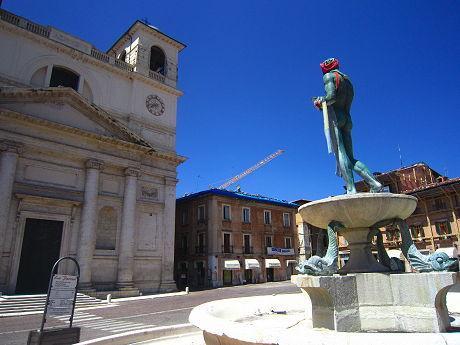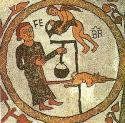Art Of The Day Weekly
#269 - from 23 August 2012 to 12 September 2012

Piazza del Duomo, L'Aquila, 4 August 2012 (Photo R. Pic)
LETTER FROM ITALY
Summer of '12
If Italy is going through hard times, its museums and monuments keep exerting a strong appeal on foreign tourists. As a perfect summer newsletter, here are some suggestions from North to South, in touch with recent openings.
IN THE AIR
What's next for L'Aquila?
ABRUZZO – Three years ago, at 3: 38 AM on 6 April 2009, the city of L'Aquila crumbled down following a devastating earthquake. Over 300 hundred persons perished and damage to the patrimony was also very important. The tragedy was quickly exploited by the government of Berlusconi which went on to show its efficiency by having the easily recognizable anti-seismic buildings on stilts pop up in the new towns on the outskirts, but little attention was given to the old part of the city. This jewel of Italian urbanism, from the Renaissance to the XXth century, was completely eliminated. A single corridor has been traced on Corso Vittorio Emanuele, from the Massimo movie theater (which has kept behind its broken glass display-window the poster of the movie shown on the doomed day, Gli amici del Bar Margherita) towards the Duomo. The highly emotional promenade gives visitors the impression of going through a ghost town, animated by the sole “carabinieri” on patrol and the few cafés with incongruent terraces. Most of the restoration projects have been delayed and met budgetary cuts while many point out the paradox: Aquila runs the risk of being blown off the map by human helplessness more than by the fury of the earth. The Italian bureaucracy is not the only one to blame: in the emotional wake that followed the tragedy the G8 summit meeting was organized on the site from 8 to 10 July 2009. A number of foreign governments pledge financial aid. It is yet to be seen …
CALABRIA

The two bronze statues of Riace © Consiglio regionale della Calabria/Soprintendenza archeologica della Calabria
The bronze statues from Riace, after 40 years of questions
REGGIO CALABRIA – The anniversary is celebrated every year on 16 August. But this year the numbers are special: the two bronze giants from Riace were discovered exactly 40 years ago, 200 meters from the coast and 7-8 metres deep. This major event is still surrounded by disquieting mysteries, recorded in a recent article in the magazine Vanity Fair, based on an investigation carried out by professor Giuseppe Braghò. Were there two or three antique statues (as one has disappeared since then)? They had fragments of spears and their shields…or did they? (They too have disappeared)? Has organized crime played a part in the disappearance of these possible elements? As we know they received a huge ransom for the kidnapping of the grandson of JP Getty, the founder of the Getty Museum. The supposed Dioscures underwent a number of treatments to save them from corrosion and they are currently at the headquarters of the Regional Council of Calabria. Simonetta Bonomi, the director of the region’s Sovrintendenza archeologica has promised though that in December, the two treasures will be shown at the museum of Magna Grecia, finally restored…
• The website dedicated to the bronzes of Riace
. The article and the photos on Vanity Fair Italy
PUGLIA
The dreams of Pantaleon
OTRANTO-Often presented as one of the most beautiful mosaic pavements in the world, the floor of the cathedral in Otranto, carried out under the orders of a mysterious ‘Pantaleone’ in the middle of the XIIth century, is completely visible, in all seasons. This is truly lucky and quite contrary to the conservation rules, and which we should enjoy before it is too late … In no way shadowed by the one in Siena, this one too is inhabited by allegoric and esoteric figures. There are animals such as the griffon, the lion, the elephant, semi-mythological characters such as Adam and Eve, king Arthur, Alexander (it is even believed the enigmatic Roman d’Alexandre may have been one of the main sources of inspiration of the work); they are all distributed on the branches of a large tree of life. When you visit, do not miss the other great ‘attraction’, the skulls of the 800 martyrs of Otranto, all victims of the scimitar of the Turkish attack in 1480, and which are kept in mural display windows.
TUSCANY
The rehabilitation of the Uffizi continues
FLORENCE -Though less spectacular than the extensions of the Louvre or of the Guggenheim, the works at the Nuovi Uffizi consist in reopening to the public historical rooms that were closed for a long time, in particular on the first floor, as they were occupied by the Archives of Florence, and in thus doubling the museum’s exhibition space. In December 2011 the Nuova Scala and the Sale Stranieri (rooms of the foreigners, with blue walls, which house the Spanish, French, Dutch and Flemish schools) were inaugurated. On 16 June 2012, the event was even more spectacular, since nine rooms, named the red rooms, dedicated to Raphaël and Tuscan painting from the XVIth century, were added to the museum’s itinerary. Not to mention the Tribuna, with its cupola, once the ‘cabinet de curiosités’ of Grand-Duke Francesco I (1541-1587) and the heart of the current museum.
The mosaics of the Duomo in Siena unveiled
SIENNA – The cathedral of Florence’s rival has been admired by a great number of foreign visitors, including Stendhal and Wagner, for its elegance, its external dual tones, and most of all because of its pavement. Traditionally the latter has been hidden under a wooden protection. But it will be exceptionally visible for a few months through an itinerary of visits that will allow a lucky few to get close to its most famous and enigmatic characters– the sibyls, Hermes Trismegiste, Aristotle, the female wolf of Sienna, to which the greatest local artists, from Sassetta à Domenico Beccafumi, participated. While another icon of Sienna, the Palio, has been the object of much criticism this summer following the fall and injuries of six horses during the last edition on 16 August, the Duomo will undoubtedly have a full house until the beginning of the autumn.
• The mosaics of the Duomo are visible to the public from 18 August to 24 October 2012.
SICILY

© Regione Siciliana Assessorato dei Beni Culturali e dell'Identità Siciliana Dipartimento dei Beni Culturali e dell'Identità Siciliana - Parco Archeologico della Villa Romana del Casale e delle aree archeologiche di Piazza Armerina e dei Comuni limitrofi - All rights reserved.
Villa del Casale back to Roman splendour
PIAZZA ARMERINA – Was this the property of a powerful senator, or a direct commission from the Emperor? The debate continues regarding the origin of the Roman Villa of the Casale, one of the most sumptuous from the IVth century of our era, in Sicily, in what is today the province of Enna, in the centre of the island. The villa is famous for its mosaics that cover an area of 3000 m2, and in which female bathers clad in bikinis play ball and other characters hunt wild animals in Africa. The villa is undoubtedly not an isolated palace as recent diggings show, and was rather at the heart of a much larger complex. Archaeologists Pace, Orsi and Gentili “rediscovered” it in the XXth century, and the Villa del Casale was included in the world heritage list of the Unesco in 1997. It needed a complete cover and a system of walkways from which to admire the mosaics. After five years of works and an investment of some €20 million, the site reopened to the public in July.



